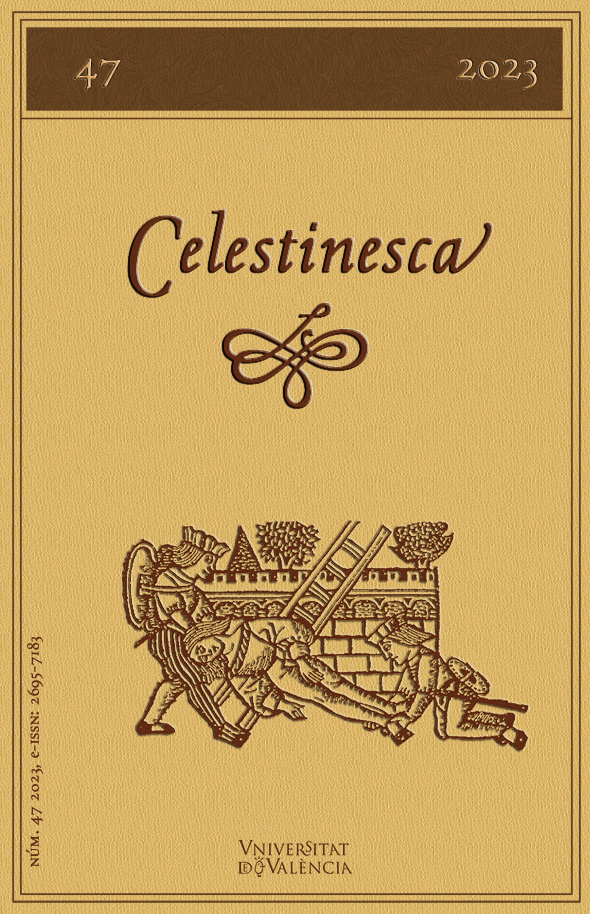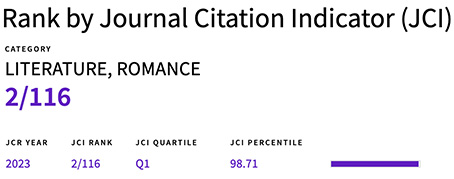Espectadores, cadáveres y discursos médicos en Celestina
DOI:
https://doi.org/10.7203/Celestinesca.47.25941Palabras clave:
Cadáveres, Espectadores, Medicina, Mirada, Modernidad Resumen
Resumen
Este artículo examina la convergencia de la noción del espectador, la imaginación literaria y el discurso médico en Celestina. La representación de cadáveres en este texto proyecta la obra de Rojas hacia la modernidad temprana como precursor del discurso anatómico que examina el interior del cuerpo y que no surgiría en la Península ibérica hasta la segunda década del siglo XVI. A través del marco teórico de los Estudios visuales, los Estudios del cuerpo y los Estudios literarios, este artículo analiza el concepto de la mirada y la representación de cadáveres en Celestina como una narrativa transgresora, que en 1499 pone a prueba los límites entre anatomías reales y metafóricas. Desde esta perspectiva, la imaginación literaria de Rojas vis à vis con la transición de una mirada médica medieval a una premoderna permiten profundizar en una comprensión post-medieval del concepto del cadáver en los albores de la modernidad en Iberia.
 Descargas
Descargas
 Citas
Citas
Amasuno, Marcelino V. (2006), Sobre la “aegritudo amoris” y otras cuestiones fisiátricas en “La Celestina", Madrid, Consejo Superior de Investigaciones Científicas.
Augustine (1963), The Confessions of St. Augustine, Rex Warner (trans.), New York, Penguin Books.
Augustine (2005), On Christian Belief, Matthew O’Connell (trans.), The Works of Saint Augustine. A Translation for the 21st Century, vol. 8, Boniface Ramsey (ed.), New York, New York, City Press.
Ariès, Philippe (1994), Western Attitudes Towards Death. From the Middle Ages to the Present, Patricia M. Ranum (trans.), Baltimore, The Johns Hopkins University Press.
Aristotle (2000), History of Animals, D’Arcy Wentworth Thompson (trans.), South Bend, Infomotions Inc.
Bergman, Ted (2012), “La Celestina and the Popularization of Graphic Criminal Violence,” Celestinesca, 36, pp. 47-70. https://doi.org/10.7203/Celestinesca.36.20146
Biblia de Jerusalén (1975), Bilbao, Desclee de Barouwer.
Brooks, Peter (2009), Body Works. Objects of Desire in Modern Narrative, Cambridge, Harvard University Press.
Bronfen, Elisabeth (1992), Over her Dead body: Death, Femininity and the Aesthetic, Manchester, Manchester University Press.
Burke, James (2000), Vision, the Gaze, and the Function of the Senses, University Park, State University Press.
Bynum, Caroline Walker (2017), The Resurrection of the Body in Western Christianity 200-1336, New York, Columbia University Press.
Durán i Escribà, Xavier (2108), La Ciencia en la literatura. Un viaje por la historia de la ciencia vista por escritores de todos los tiempos, Barcelona, Universidad de Barcelona.
Enders, Jody (2002), The Medieval Theater of Cruelty. Rhetoric, Memory, and Violence, Ithaca, Cornell University Press.
Estienne, Charles (2016), La Dissection des Parties du Corps Humain, Divisée en 3 Livres, París, Hachette Livre.
Fabié, Antonio María (ed.) (1886), Algunas obras del doctor Francisco López de Villalobos, Madrid, Sociedad de Bibliófilos Españoles.
Fernández, Enrique (2018), Anxieties of Interiority and Dissection in Early Modern Spain, Toronto, University of Toronto Press.
Gerli, Michael (2017), "Celestina" and the Ends of Desire. Toronto, University of Toronto Press.
Gordonio, Bernardo (1993). Lilio de medicina, Brian Dutton and M.ª Nieves Sánchez (ed.), Madrid, Arco Libros.
Guldin, Rainer (2002), “The Dis-membered Body: Bodily Fragmentation as a Metaphor for Political Renewal,” Physis: Rev. Saúde Coletiva, 12.1, pp. 221-234. https://doi.org/10.1590/S0103-73312002000200003
Harney, Michael P. (2004), “Violence in the Spanish Chivalric Romance,” Violence in Medieval Courtly Literature: A Casebook, Albrecht Classen (ed.), New York, Taylor & Francis Group, pp. 300-316.
Huarte, Juan (1946), Examen de ingenios para las ciencias, Madrid, Espasa-Calpe.
Hutchenson, Linda (1988), A Poetics of Postmodernism: History, Theory, Fiction, New York: Routledge.
Jay, Martin (1988), “Scopic Regimes of Modernity.” In Hal Foster (Ed.), Vision and Visuality, Seattle, Bay Press, pp. 3-23.
Jay, Martin (1996), “Vision in Contexts: Reflections and Refractions.” In Teresa Brennan and Martin Jay (Eds.), Vision in Context: Historical and Contemporary Perspectives on Sight, New York, Routledge, pp. 1-14.
Kristeva, Julia (1982), Powers of Horror. An Essay on Abjection, Leon S. Roudiez (Trans.), New York, Columbia.
Labbie, Erin Felicia, and Allie Terry-Fritsch (2016), “Introduction: Beholding Violence,”, in Allie Terry-Fritsch and Erin Felicia Labbie (ed.), Beholding Violence in Medieval and Early Modern Europe, London, Routledge, pp. 1-14.
Lacarra Lanz, Eukene, “El erotismo en la relación de Calisto y Melibea”, in Pilar Carrasco (ed.), El mundo como contienda: estudios sobre "La Celestina," Málaga, Universidad de Málaga, pp. 127-145.
Lawrance, Jeremy (2009), “Representations of Violence in 15th-century Spanish Literature”, The Bulletin of Hispanic Studies, 86.1, pp. 95-103. https://doi.org/10.1353/bhs.0.0001
Le Goff, Jacques (1988), The Medieval Imagination, Arthur Goldhammer (trans.), Chicago, Chicago University Press.
The Lives of Thomas Becket (2001), Michael Stauton (ed. and trans.), Manchester, Manchester University Press.
Maravall, José Antonio (1978), Antiguos y modernos: visión de la historia e idea del progreso hasta el Renacimiento, Madrid, Sociedad de Estudios y Publicaciones.
Meyerson, Mark, Daniel Thiery, and Oren Falk (2004), "Introduction", in Mark Meyerson, Daniel Thiery, and Oren Falk (ed.), "A Great Effusion of Blood?": Interpreting Medieval Violence, Toronto, University of Toronto Press, pp. 3-18.
Miller, William (1997), The Anatomy of Disgust, Cambridge, Harvard University Press.
Mitchell, W. J. T. (2016), "Foreword", in Allie Terry-Fritsch and Erin Felicia Labbie (ed.), Beholding Violence in Medieval and Early Modern Europe, London, Routledge, pp. xv-xxvi.
Mitchell, W. J. T. (1994), Picture Theory: Essay in Verbal and Visual Representation, Chicago, The University of Chicago Press.
Morros Mestres, Bienvenido (2009). “Melancolía y amor hereos en La Celestina”, Revista de Poética Medieval, 22, pp. 133-183.
Ovid (1999), Metamorphoses, D. E. Hill (ed.), Warminster, Aris & Phillips LTD.
Rokem, Freddie (2002), “Witnessing Woyzeck: Theatricality and Empowerment of the Spectator”, SubStance, 31:2/3:98/99, pp. 167-183. https://doi.org/10.1353/sub.2002.0038
Rojas, Fernando de (1998), La Celestina, Dorothy S. Severin (ed.), Madrid, Cátedra.
Rubin, Miri (1994), “The Person in the Form: Medieval Challenges to Bodily ‘order’”, Framing Medieval Bodies, Manchester, Manchester University Press, pp. 100-122.
Šabec, Maja (2012), “El papel de la enfermedad de amor en la Tragicomedia de Calisto y Melibea”, Tropelías. Revista de Teoría de la Literatura y Literatura Comparada, 18, pp. 308-325. https://doi.org/10.26754/ojs_tropelias/tropelias.201218561
San Juan, Rose Marie (2013), “The Turn of the Skull: Andreas Vesalius and the Early Modern Memento Mori”, in Angela Vanhaelen and Bronwen Wilson (ed.), The Erotics of Looking: Early Modern Netherlandish Art, Hoboken, John Wiley & Sons, pp. 93-109.
Sanmartín Bastida, Rebeca (2005), “Sobre el teatro de la muerte en La Celestina: El cuerpo ‘hecho pedazos’ y la ambigüedad macabra”, e-Humanista, 5, pp. 113-125. https://www.ehumanista.ucsb.edu/volumes/5 [accedido el 10/1/2023]
Sanmartín Bastida, Rebeca (2006), “Los testigos de la ruina en La Celestina: Sosia y Pleberio, voyeurs e intermediarios del arte macabro”, in Antonio Manuel Ferreira and Paulo Alexandre Pereira (ed.), Escrever a ruína, Aveiro, Universidade de Aveiro, pp. 187-196.
Sawday, Jonathan (1995), The Body Emblazoned: Dissection and the Human Body in Renaissance Culture, London – New York, Routledge.
Scarry, Elaine (1985), The Body in Pain. The Making and Unmaking of the World, Oxford, Oxford University Press.
Scarry, Elaine (1994), Resisting Representation, Oxford, Oxford University Press.
Scott, Rachel (2017), "Celestina" and the Human Condition in Early Modern Spain and Italy, Suffolk, Boydell & Brewer.
Schmitz-Esser, Romedio (2020), The Corpse in the Middle Ages: Embalming, Cremating, and the Cultural Construction of the Dead Body, Albrecht Cassen and Carolin Radtke (ed.), London – Turnhout, Harvey Miller Publishers.
Schwartz, Margaret (2015), Dead Matter: The Meaning of Iconic Corpses, Minneapolis, University of Minnesota.
Skaarup, Bjørn Okholm (2015), Anatomy and Anatomists in Early Modern Spain. The History of Medicine in Context, Farnham, Ashgate.
Valverde Amusco, Juan (2005), Historia de la composición del cuerpo humano, Valladolid, Maxtor.
Verdery, Katherine (1999), The Political Lives of Dead bodies and Postsocialist Change, New York, Columbia University Press.
Vicente Pedraz, Miguel (2016), “El cuerpo de la República. Una metáfora organicista en tres discursos médicos del Siglo de Oro español,” Brocar,40, pp. 43-62. http://doi.org/10.18172/brocar.3240
Vicente Pedraz, Miguel (2009), “Saber médico e ideología en el Libro de la Anathomía del hombre de Bernardino Montaña de Monserrate: tradición y modernidad en la alegoría onírica del cuerpo social”, The Bulletin of Hispanic Studies, 86:5, pp. 593-607. https://doi.org/10.1353/bhs.0.0093
Whinnom, Keith (1981), “Interpreting Celestina: The Motives and the Personality of Fernando de Rojas”, Mediaeval and Renaissance Studies on Spain and Portugal in Honour of P. E. Russell, Oxford, Society for the Study of Mediaeval Languages and Literatures, pp. 53-68.
Descargas
Publicado
Cómo citar
-
Resumen186
-
PDF 307
Número
Sección
Licencia
![]() La revista Celestinesca apuesta por la difusión del conocimiento, por eso el acceso a sus contenidos es libre y se rige por una licencia Creative Commons Reconocimiento-NoComercial-SinObraDerivada 4.0
La revista Celestinesca apuesta por la difusión del conocimiento, por eso el acceso a sus contenidos es libre y se rige por una licencia Creative Commons Reconocimiento-NoComercial-SinObraDerivada 4.0
Los autores conservan los derechos sobre sus trabajos. Por lo tanto, pueden difundirlos y depositarlos en los repositiorios, institucionales o no, que deseen, si bien se ruega que lo hagan proporcionando la referencia bibliográfica completa y el DOI correspondiente.
Celestinesca no cobra a sus autores ningún tipo de cargo económico por la gestión y publicación de los artículos enviados.





